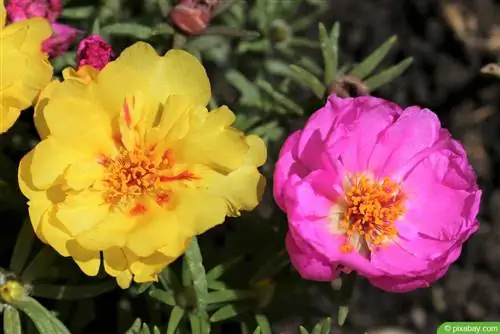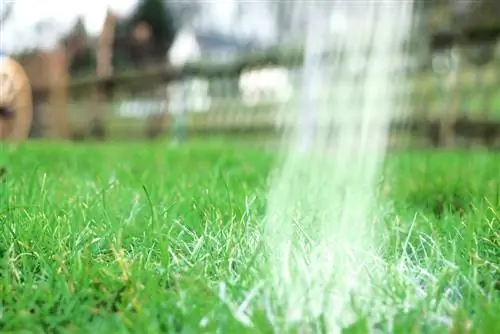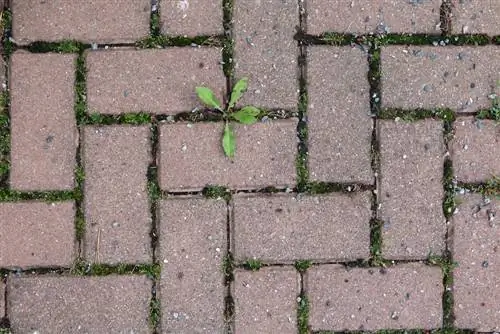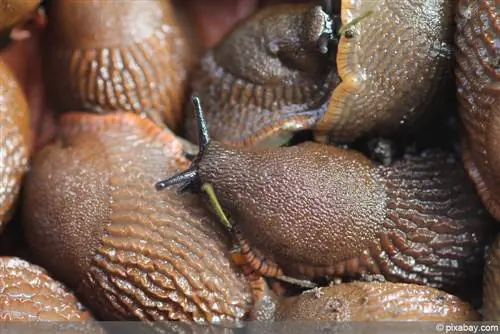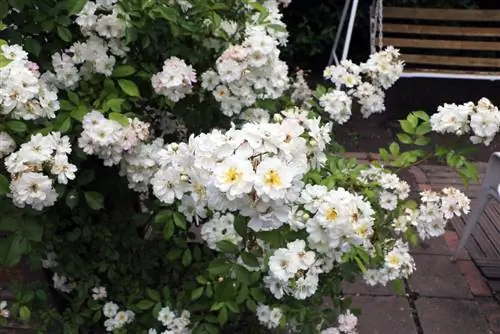- Author admin [email protected].
- Public 2023-12-17 03:39.
- Last modified 2025-01-24 12:45.
Once standard in traditional cottage gardens, the moss rose was somewhat forgotten over time and could only be admired as an image on old porcelain. It is now being rediscovered again and is finding more and more fans. It grows as a large shrub with heights of up to 180 cm. The moss flower blooms once and develops colorful, medium-sized, double flowers.
Profile
- Genus: Mutation of the Centifolia
- Botanical name: Rosa centifolia var. muscosa
- German name: moss rose, moss rose
- Growth: falling apart, overhanging shoots
- Growth height: 150-180 cm
- Leaf: gray-green, slightly shiny
- Flower: medium-sized, double, various shades of pink
- Flowering period: June to August
- Fragrance: intense with a slightly spicy note
- Lime compatibility: lime tolerant
- Use: Farm and natural gardens, as a solitary or background plant
Location
Rosa centifolia var. Muscosa is one of the oldest rose varieties for good reason; they are very robust and not very susceptible to disease. The right location is particularly important. It should be airy and sunny with several hours of sun every day. A place in full midday sun should be avoided. An airy location is important so that the leaves can dry quickly. As a result, space under larger deciduous trees is rather unsuitable. A planting site that is unprotected from heavy rain increases susceptibility to fungal diseases such as sooty mold and powdery mildew. The right location can also make care much easier.
Floor
When it comes to soil conditions, moss roses should not be planted where roses, apples, pears, plums or cherries have already grown in previous years. Otherwise, soil fatigue can occur. Even the best care is of no use. The plants grow more poorly, have weak shoots and flower production is greatly reduced. The main cause is said to be pathogens or root-damaging bacteria. Roses don't thrive there even after more than ten years.
- Mixing rose-tired soil with fresh soil, not enough
- Complete, large-scale replacement required
- To a depth of at least 80 cm
- Find a location with uncontaminated soil
- Making contaminated soil fit for the long term
- Apply compost and algae lime
- Soil is thus supplied with trace elements
- Then sow a green manure, e.g. with yellow mustard and marigolds
- Provides soil with humus and displaces nematodes
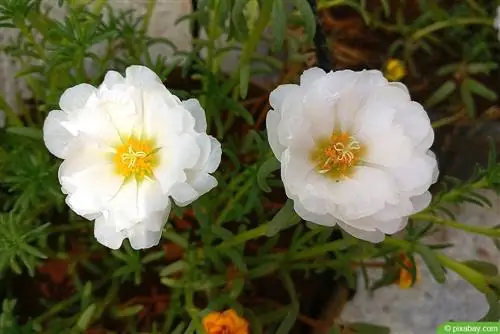
The soil at the new location should be rich in nutrients and humus, moderately dry to moderately moist and neutral to slightly acidic. Gravelly to clayey soils are very good. Heavy ones can be improved with sand and light ones with a good portion of compost or well-seasoned manure.
Planting
Before planting, the substrate must be carefully prepared. You loosen it to a depth of about 50 cm and free it from root weeds such as groundweed and couch grass and other root residues.
- Then dig out the planting hole
- About twice as deep and wide as the bale
- Because of taproots, more deep than wide
- Mix excavated soil with well-rotted compost or humus
- Water balls of bare-rooted moss flowers for 12 to 24 hours
- Containerware until no more air bubbles rise
- In the next step, shorten the rose shoots to 20 cm
- Prune the roots too
- Loose the balls of container plants by gently pulling them
Then the moss rose can be planted and watered. Planting time for a bare-root Rosa centifolia var. Muscosa is in autumn and spring, but preferably in autumn. Container plants can be planted all year round as long as the soil is frost-free.
Care instructions
This moss rose is the perfect solitary plant, but also looks great in borders. Because of their compact growth and a height of approx.150 cm, it is even suitable as a hedge and container plant. Like any other plant, the moss rose also requires appropriate care for he althy and strong growth and an inexhaustible abundance of flowers.
Pouring
The water requirements of these plants are rather moderate, although they require a little more water in summer than in spring and autumn. Depending on the weather, once or twice a week is sufficient, perhaps more often in summer. Depending on the location, specimens in pots need a little more water. The substrate dries out more quickly here due to the smaller volume.
The best time of day to water is in the morning. You should make sure to always pour onto the ground and not over the leaves. The wet leaves could be affected by powdery mildew. Consequently, watering with a garden sprinkler is not recommended.
Tip:
Depending on the fertility of the soil and the water supply, weeds can settle around the rose and represent serious competition. That's why regular weeding should be part of the care.
Fertilize
Another important part of care is fertilization. The moss rose is fertilized in three stages. The first fertilization takes place in March in the form of a light dose of compost. The second follows in May and the last at the end of June, but at the latest at the end of July, both times with a special rose fertilizer. You should stop fertilizing at a later date so that the plants can rest. To ensure this, the nitrogen content in the soil must decrease. If this doesn't happen, the roses will still be active at the end of the year, which can cause damage during the first strong night frosts.
Tip:
Moss roses in pots can be supplied with a liquid fertilizer every 14 days from April to July inclusive.
Cutting
- Cut moss flowers a maximum of every two to three years
- Best time in spring
- Cut rather conservatively
- Cut off diseased, frozen and dead shoots close to the ground
- Cutting out thin shoots from the middle
- Provides better ventilation inside the plant
- Short new shoots by a third in autumn
- Formation of new flower heads in the same year
Enough older shoots should be left standing, because this rose blooms on perennial wood. Ultimately, about the same number of old, previous year's and new shoots should remain on the rose. You should always cut just above an outward-facing eye and slightly at an angle.
Wintering
The importance of winter protection for moss roses is often underestimated. They are considered to be partially hardy and are grateful for appropriate protection. To protect the roots, pile up the soil around the rose and wrap the upper parts with a special rose fleece, burlap or jute. Moss flowers need a little more protection in pots. The earth can freeze quickly here. Water absorption would come to a standstill and the plant would dry out. To prevent this, wrap the bucket in jute, coconut mats or bubble wrap and also cover the bale with brushwood or dry leaves. To protect against ground frost, place it on feet or Styrofoam and then in front of a protective house wall. Don't forget to water on frost-free days. However, excess water must be able to drain away at any time.
Transplanting
There can be many reasons for transplanting a moss rose. The right time is particularly important here. This is between the beginning of November and the end of February, and definitely not during the growing season. If the rose is still leafy, it loses water through the leaves and its shoots can dry out.
- The older the plant, the more careful you should be
- Leave at least 50-70 cm from the main branches
- Cut back side shoots to about 10 cm
- Remove dead ones directly at the base
- If necessary, remove some of the main branches
- Evaporation area after budding is therefore smaller
- Then use the spade to cut out a generously sized root ball
- Spade should not act as a lever
- Dig roots as deep as possible
- Rose should be able to be lifted out of the ground without resistance
- Replant at the new location
- Pile up with humus until mid-March
- Or cover the base with pine branches and leaves
Tip:
Moss roses in pots should be repotted into fresh substrate at least every four to five years. Roots and shoots are shortened accordingly.
Propagation
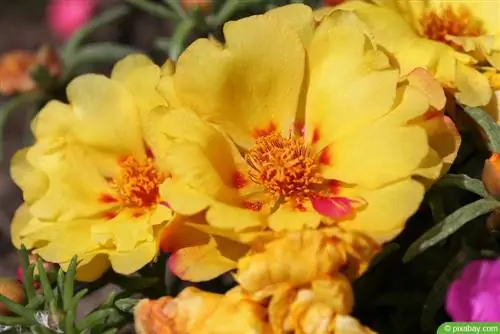
There are different ways to propagate the moss rose:
About cuttings
The required cuttings are cut between the end of June and the beginning of August from annual, well-woody shoots that have, at best, just flowered. They should be about pencil length and have about five eyes. The cuttings can be planted directly in a sheltered spot in the garden or in pots with slightly sandy garden soil.
When planting in a pot, make sure that the respective planter is around 30-40 cm deep. In addition, good water drainage must be guaranteed. To speed up rooting, you can place large disposable glasses or translucent plastic bags over the cuttings. The substrate should not dry out during this time. In the spring of the following year, the rose cuttings can then be planted in their final location.
By sowing
- First fill a shallow seed tray with potting soil
- Distribute the seeds evenly
- Cover with soil about a centimeter thick
- Moisten the substrate and keep it moist until germination
- Place the seed tray in a cool place over the winter
- If the first seedlings are visible, place the whole thing brighter and warmer
- Avoid direct sunlight
As soon as the young plants have four to six leaves, they can be separated into small pots with nutrient-rich soil. They should only be planted in the garden or in pots after the Ice Saints at the earliest, when frost is no longer expected. In the first few days you water them daily depending on the weather. From the second week onwards, you can water less frequently.
Tip:
It can sometimes take several months for the seeds to germinate. So if they don't germinate quickly, there's no reason to worry.
Diseases
Powdery mildew
Under optimal conditions, the moss rose 'Rosa centifolia var. Muscosa' is less susceptible to disease. However, mildew infestation cannot be completely ruled out. It appears as a white, mealy coating on leaves, stems and buds. This is followed by growth disorders and deformities. Suitable fungicides are available for effective control. Good location conditions are particularly important as a preventive measure. You can also work with home-made plant broths.
Star sooty dew
Star sooty mold manifests itself in black-brown leaf spots of varying sizes. This is followed by yellowing of the leaves and premature loss of leaves. As soon as the first symptoms appear, you should start taking countermeasures. The trade also offers approved fungicides, which usually require repeated treatment.
Rose Rust
Rose rust occurs in spring and causes bright orange-brown pustules on the undersides of leaves and yellowish spots on the upper sides. The cause here is also unfavorable location conditions. Appropriate fungicides are again available to combat this.
Pests
The most common pests on roses are aphids. They like to settle on rose bushes in spring or summer. Infestation can usually be reduced with a strong jet of water. For further combat, you can use self-made soapy water for spraying. The whole thing has to be repeated several times until no more lice can be seen.

